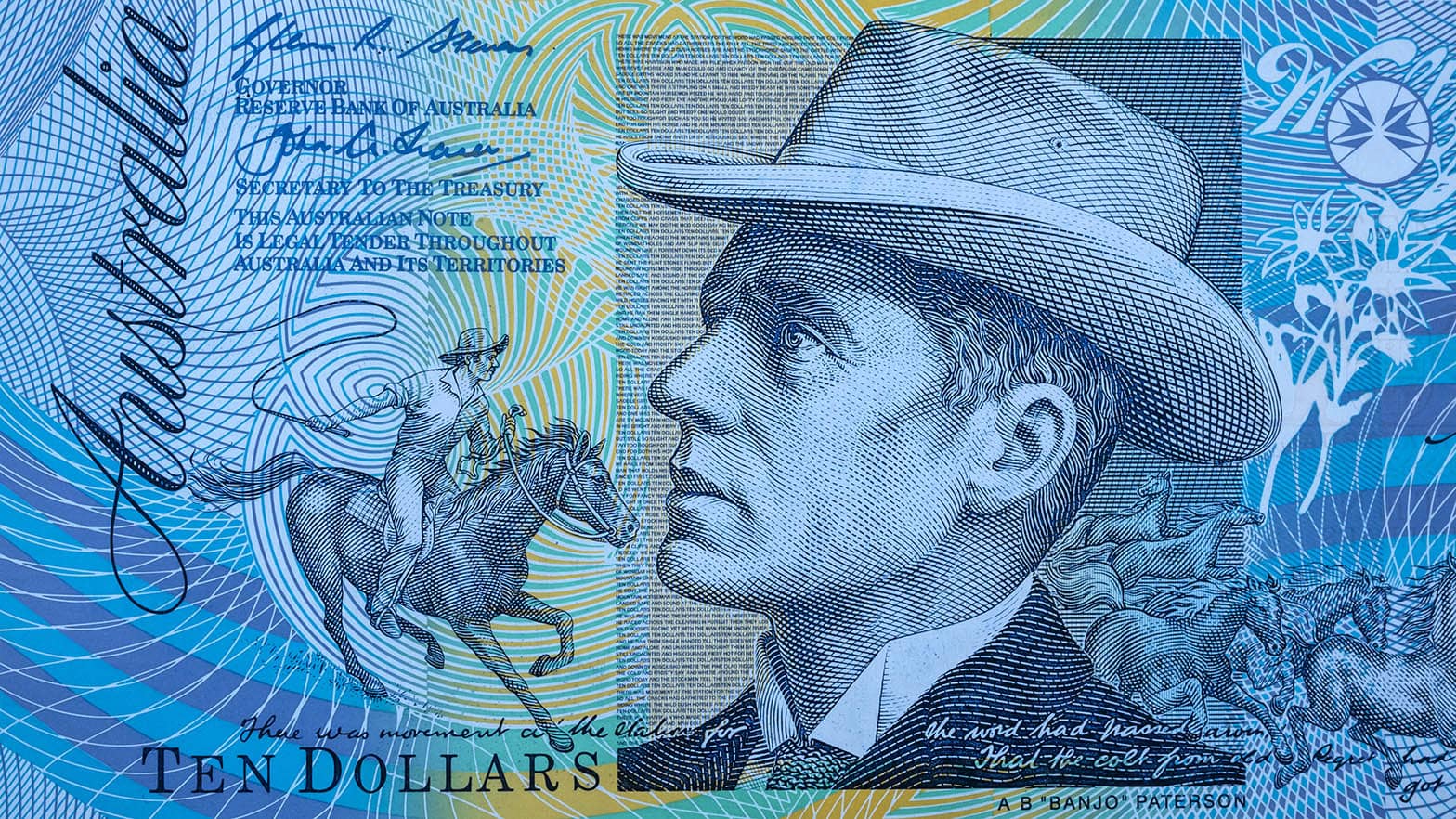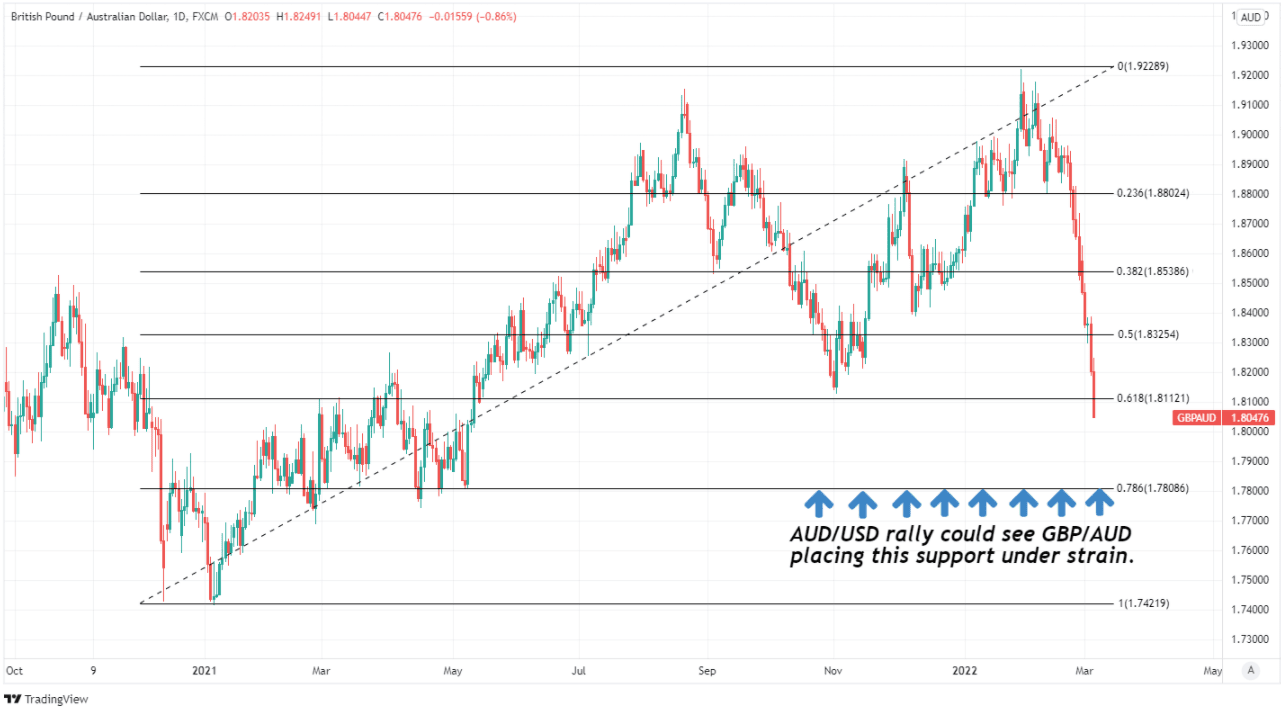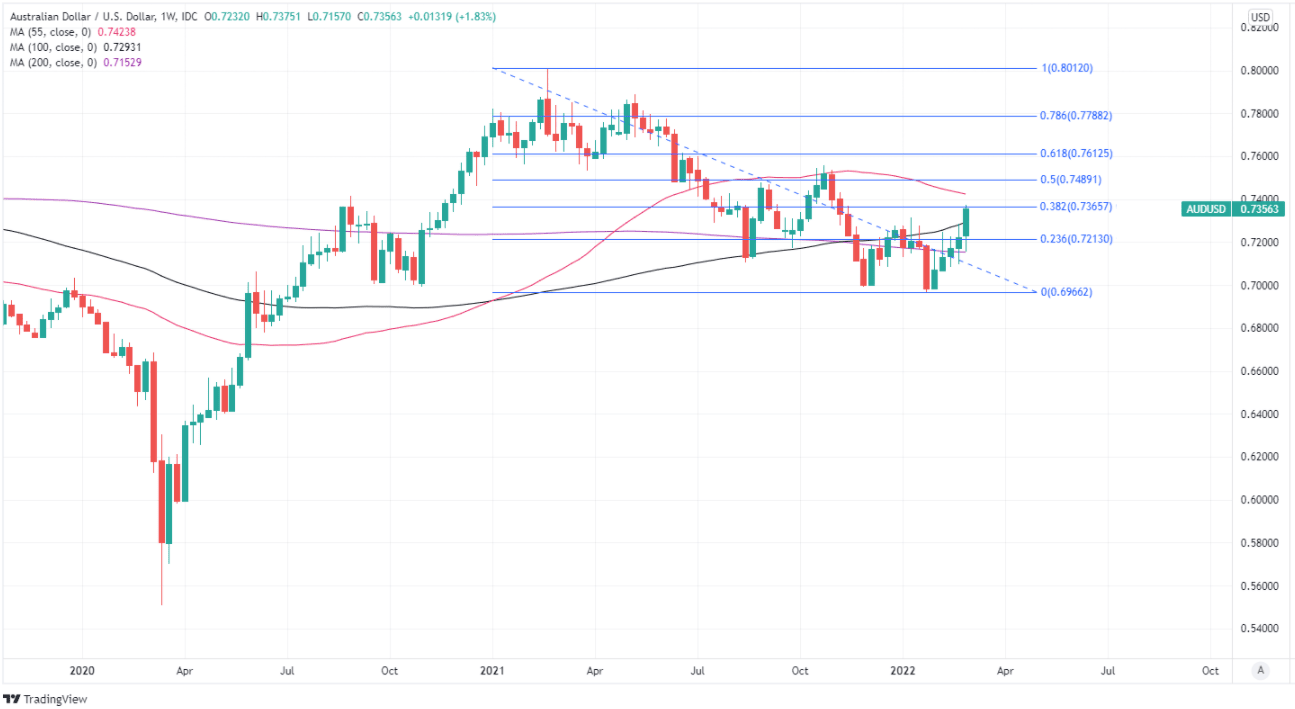"Risky Safe Haven" Australian Dollar Could Push GBP/AUD Sub 1.78
- Written by: James Skinner
- AUD cementing its grip on top spot in major FX
- As Ukraine gives relevance to commodities’ rally
- Russia sanctions could augur investment boom
- AUD/USD’s rally could push GBP/AUD sub 1.78

Image © Adobe Images
The Pound to Australian Dollar exchange rate was close to signing off on its steepest decline for more than a year in the final session of the week as a strong and ongoing rally in AUD/USD appeared set to push GBP/AUD to 1.78 and below over the coming days.
Australia’s Dollar had reversed two thirds of its late 2021 decline against the U.S. Dollar by Friday in a barnstorming rally that has cemented its position as the best performer within the G10 contingent of major currencies while placing it in close contest with the Brazilian Real for the top spot in G20.
“The usual suspect this time of year tends to be large dividend payments by resource companies and associated AUD buying. However, other more durable factors matter - most importantly the implication of recent events for Australia's key commodity export prices,” says Adarsh Sinha, a Hong Kong based FX strategist at BofA Global Research, who this week described the Aussie as a “risky safe haven.”
“Longer-term, a recovery in service exports as borders reopen and Australia's record net foreign asset position in equities may contribute towards lowering AUD's sensitivity to global risk sentiment on a more durable basis,” Sinha and colleagues Janice Xue also said in a Wednesday note.
Above: Pound to Australian Dollar rate at daily intervals with Fibonacci retracements of 2021 rally indicating possible areas of support for Sterling.
- GBP to AUD reference rates at publication:
Spot: 1.8083 - High street bank rates (indicative band): 1.7450-1.7577
- Payment specialist rates (indicative band): 1.7920-1.7993
- Find out about specialist rates, here
- Set up an exchange rate alert, here
Australia’s Dollar has risen from bottom of the major league table to the top in barely a fortnight and a rally right the way across the commodity complex is front and centre as a possible driver of the recovery.
It could also have been aided by a capitulation of bearish speculative wagers against the antipodean currency; wagers that had been the largest in the market as recently as the end of February.
“There has been a persistent gap between AUD and its commodity export prices in recent years partly because the rally was perceived to be temporary (reflected in deeply inverted forward curves across most commodities). However, this has become a tenuous assumption in light of recent events. A meaningfully stronger terms of trade is likely to provide some buffer for AUD even if global growth sentiment deteriorates,” Sinha and Xue both said.
The Australian Dollar’s response to commodity price rallies often appears to be inconsistent - but isn’t really all that inconsistent - as it does not always follow commodity prices higher.
{wbamp-hide start}
{wbamp-hide end}{wbamp-show start}{wbamp-show end}
The main difference between the occasions when it does or doesn’t is whether the underlying moves in resource prices will or won’t eventually have implications for the Reserve Bank of Australia (RBA) inflation target.
In this instance there is a credible prospect of rising commodity prices actually triggering an upswing in capital expenditure and other kinds of investment within the Australian economy, potentially leading to increased employment and growth in household incomes within a labour market where unemployment is already at historic lows and wage pressures are already building.
“The scale of the surge in commodity prices is stunning, including Australian export staples LNG, coal, wheat, iron ore and aluminium. It comes after Australia recorded an 8% jump in exports in January, producing the second-largest surplus on record, $12.9bn. Still, the global growth outlook is cooling, typically a clear negative for the Aussie,” says Sean Callow, a senior currency strategist at Westpac.
Russia’s attempted conquest of Ukraine has seen some of the most aggressive sanctions in history aimed at the state and connected entities, which has raised the risk and costs associated with Russian commodities and could ultimately take them off the market for many countries and economies; which potentially offers historic opportunities to Australia’s industrial resources sector and Brazil’s agricultural commodity sector.
The barnstorming rally in AUD/USD - which has a direct influence on GBP/AUD - could ultimately push the Pound to Australian Dollar rate to 1.78 or below if the main Australian exchange rate manages to break above the 0.74 handle over the coming days.
Above: AUD/USD shown at weekly intervals with major moving-averages and Fibonacci retracements of February 2021 decline indicating prospective areas of technical resistance to a further Aussie Dollar recovery.
Secure a retail exchange rate that is between 3-5% stronger than offered by leading banks, learn more.
“AUD/GBP continues to make gains though it has not yet reached our short‑term guidance of 0.5600 [GBP/AUD: 1.7857]. In the current environment, what is bad for EUR is bad for GBP because the UK is highly dependent on the Eurozone economy,” says Joseph Capurso, head of international economics at Commonwealth Bank of Australia.
Australia’s Dollar has been a significant driver of GBP/AUD losses but not the sole driver as Sterling has itself come under significant pressure due to at least three side effects of the conflict in Ukraine including a steep decline in European single currency when measured against the greenback.
Reasons for Sterling’s decline against the greenback include the UK’s economic exposure to the Eurozone economy, the sale of official reserves by central banks in emerging market economies and recent losses sustained by the European single currency.
Euro-Dollar declines have been hefty enough to lift the GBP/EUR rate to its highest since June 24, 2016 and this particular pairing accounts for around half of the overall trade-weighted British Pound; meaning that Sterling hasn’t actually depreciated despite steep losses against many currencies.
"If countries sell USD reserves in an effort to directly manage their exchange rates, reserve managers may take rebalancing operations—in this case, buying USD against other reserve currencies (like EUR or GBP) to return the currency composition of their portfolio back to target levels. As a result, FX intervention may paradoxically boost the Dollar versus certain G10 crosses," writes Karen Reichgott Fishman, a senior economist at Goldman Sachs.
"If EM central banks begin accumulating USD reserves again as the economy recovers, these same rebalancing flows may weigh on the Dollar, particularly versus other major reserve currencies, like the Euro," Fishman and colleagues said in an April 2020 research note.







